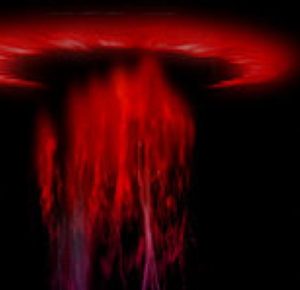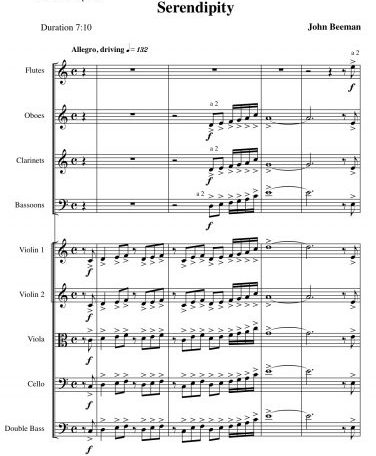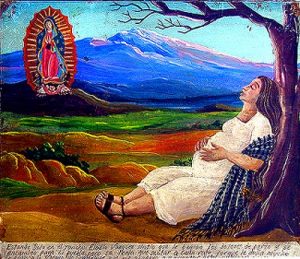- Sprites
- (2013) for chamber orchestra, duration 7:30.
- Sprites are immense, but brief, flashes of red light that appear above thunderstorms. This unusual weather phenomenon was only first documented in 1989.
 This composition, Sprites, was inspired by these unique weather events.
This composition, Sprites, was inspired by these unique weather events. - Serendipity
- (2010) for orchestra, duration 7:10. Performed by the Mission Chamber Orchestra, Emily Ray. conductor

- Phoenix Rising
- (2007) Listen to July 7, 2007 performance by the San Francisco Composers Chamber Orchestra. Duration 6:04.
- Ashes Falling
- (2005) Listen to performance by San Francisco Composers Chamber Orchestra on June 10, 2005. Duration 6:28.
- Free Form
- (2004) for alto sax and orchestra. Listen to September 25, 2004 performance by the San Francisco Composers Chamber Orchestra, Palo Alto, California, Michael Cooke, alto sax. Duration 6:40.
- Smoke and Mirrors
- (2004) Premiere: May 9, 2004, San Francisco, Calfornia. Duration 7:15.
- Four Retablos For Soprano and Orchestra
- (2003) orchestral version of my most performed composition, based on anonymous Mexican folk paintings with texts that offer thanks to God. Duration 15:00.

- Beeline: A Concert Overture
- (2002) A beeline is usually defined as the shortest distance between two points, but anyone who has watched a bee fly knows this is not true at all. The insect often flies in a divergent, zigzag course and only makes a straight arrow approach when going directly to the hive. The form of this overture metaphorically follows the same path. Listen to 2005 performance by the Mission Chamber Orchestra. Duration: 4:40.
- Concerto for Electric Guitar
- (1998) The Concerto for Electric Guitar and Orchestra premiered on January 19, 2001 at the San Mateo Performing Arts Center and on January 20, 2001 at the Flint Center in Cupertino. The soloist was Paul Dresher, and the orchestra was the Peninsula Symphony conducted by Mitchell Sardou Klein. The Concerto for Electric Guitar and Orchestra uses elements of blues, rock and jazz in addition to contemporary techniques. the concerto form, rather than the usual “struggle” with the orchestra, focuses, more on dialogue with the ensemble.Duration: approximately 22 minutes. Listen to movement 3 with an amazing cadenza by Paul Dresher:
- The Rogue River Canyon: A Suite for Chamber Orchestra
- (1995) Rogue River Canyon: A Suite for Chamber Orchestra (in five movements) was completed in June 1995. Inspired by a five day whitewater rafting trip down the majestic Rogue River of southern Oregon, the piece depicts the journey through music. The impression is not meant to be literal, but instead attempts to stimulate the listener on an emotional and perhaps subliminal level. Different musical techniques are used freely as required. Flowing rhythms and consonant harmonies create a peaceful mood in the second movement, “Day on the River.” However, the thundering turbulence of the last movement, “Blossom Bar: The Great Rapids” is achieved through crashing dissonance and jagged, complex rhythms. Moving water is created with various techniques throughout the suite: gentle ripples as shimmering percussion, whirlpools swell with low woodwinds, and surging wavers come as driving strings and brass.In addition to the changing mood of the river itself, other aspects of the natural scene are depicted in the music. Open harmonies reminiscent of Copland suggest the nearby temperate forest and its inhabitants. Bird calls are heard as flutters in the woodwinds and violin trills: hoots sound in oboe, english horn and clarinet; a lumbering bear is suggested by thumping percussion and strings.
The overall effect of the Suite with its complex and ever evolving music creates an impression of the rich diversity of nature which is found in the beautiful Rogue River Canyon.
Duration ca. 20 minutes. - Absolutely Gebrauchsmusik
- (1995) Duration: 7:30.
- Christmas Eve on Market Street
- (1987) For children’s chorus and orchestra. Duration 5:15.
- Suite on American Themes
- (1975) Suite on American Themes, a five movement composition for orchestra, is a historical-musical essay on the American character.
- The work uses folk themes from 19th and 20th century songs dealing with similar subjects to establish a link between the American character of the past and the present. In the second movement, “Spiritual Renewal,” fragments of “Shenandoah” and the contemporary song “Rocky Mountain High” are used, both of which concern the theme of renewal. Throughout the suite motives from folk songs are treated diversely. The first movement, “Patriotism, War” is a fugue; the second movement a passacaglia. Sometimes the themes are used as melody and obligato and are easily heard, at other times, they are concealed and barely recognizable.Harmonies are sometimes traditional, and other times, rich clusters are utilized. Diatonic, chromatic, pentatonic, and atonal melodies are all used. At times the music is tonal and familiar, and at other moments fresh and surprising. Some of the music is reminiscent of Charles Ives or Copland; other music brings to mind Samuel Barber or William Schuman. There are dark, mysterious sections and also joyous light-hearted music. Images of wilderness and natural scenes are suggested, as well as the celebrations of people coming together. The effect is distinctly American as a fiddle tune is heard and the suite concludes with a jubilant scherzo.
Instrumentation: Flute, Flute II (Piccolo), 2 Oboes, 2 Clarinets, Bassoon, Horn, Trumpet, 2 Percussion, Strings (Clarinets, Trumpet and Horn transposed in score).
Duration: ca. 13 minutes
Premiered: 1979, by the Fremont-Newark Philharmonic - Berge in die Nacht
- (1975)